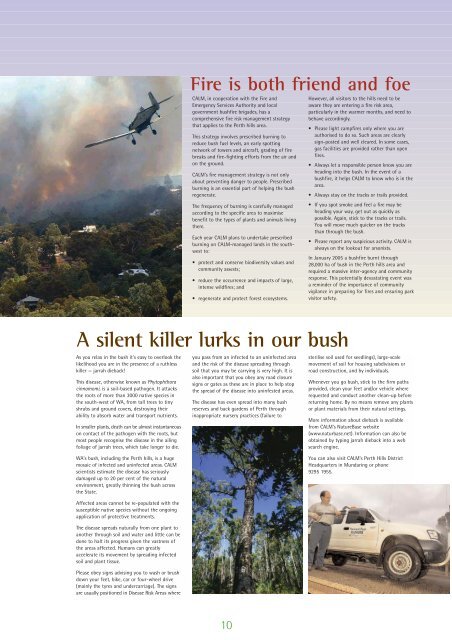2005044 hills forest magpaper - Department of Environment and ...
2005044 hills forest magpaper - Department of Environment and ...
2005044 hills forest magpaper - Department of Environment and ...
You also want an ePaper? Increase the reach of your titles
YUMPU automatically turns print PDFs into web optimized ePapers that Google loves.
Fire is both friend <strong>and</strong> foeCALM, in cooperation with the Fire <strong>and</strong>Emergency Services Authority <strong>and</strong> localgovernment bushfire brigades, has acomprehensive fire risk management strategythat applies to the Perth <strong>hills</strong> area.This strategy involves prescribed burning toreduce bush fuel levels, an early spottingnetwork <strong>of</strong> towers <strong>and</strong> aircraft, grading <strong>of</strong> firebreaks <strong>and</strong> fire-fighting efforts from the air <strong>and</strong>on the ground.CALM's fire management strategy is not onlyabout preventing danger to people. Prescribedburning is an essential part <strong>of</strong> helping the bushregenerate.However, all visitors to the <strong>hills</strong> need to beaware they are entering a fire risk area,particularly in the warmer months, <strong>and</strong> need tobehave accordingly.• Please light campfires only where you areauthorised to do so. Such areas are clearlysign-posted <strong>and</strong> well cleared. In some cases,gas facilities are provided rather than openfires.• Always let a responsible person know you areheading into the bush. In the event <strong>of</strong> abushfire, it helps CALM to know who is in thearea.• Always stay on the tracks or trails provided.The frequency <strong>of</strong> burning is carefully managedaccording to the specific area to maximisebenefit to the types <strong>of</strong> plants <strong>and</strong> animals livingthere.Each year CALM plans to undertake prescribedburning on CALM-managed l<strong>and</strong>s in the southwestto:• protect <strong>and</strong> conserve biodiversity values <strong>and</strong>community assests;• reduce the occurrence <strong>and</strong> impacts <strong>of</strong> large,intense wildfires; <strong>and</strong>• regenerate <strong>and</strong> protect <strong>forest</strong> ecosystems.• If you spot smoke <strong>and</strong> feel a fire may beheading your way, get out as quickly aspossible. Again, stick to the tracks or trails.You will move much quicker on the tracksthan through the bush.• Please report any suspicious activity. CALM isalways on the lookout for arsonists.In January 2005 a bushfire burnt through28,000 ha <strong>of</strong> bush in the Perth <strong>hills</strong> area <strong>and</strong>required a massive inter-agency <strong>and</strong> communityresponse. This potentially devastating event wasa reminder <strong>of</strong> the importance <strong>of</strong> communityvigilance in preparing for fires <strong>and</strong> ensuring parkvisitor safety.A silent killer lurks in our bushAs you relax in the bush it's easy to overlook thelikelihood you are in the presence <strong>of</strong> a ruthlesskiller — jarrah dieback!This disease, otherwise known as Phytophthoracinnamomi, is a soil-based pathogen. It attacksthe roots <strong>of</strong> more than 3000 native species inthe south-west <strong>of</strong> WA, from tall trees to tinyshrubs <strong>and</strong> ground covers, destroying theirability to absorb water <strong>and</strong> transport nutrients.In smaller plants, death can be almost instantaneouson contact <strong>of</strong> the pathogen with the roots, butmost people recognise the disease in the ailingfoliage <strong>of</strong> jarrah trees, which take longer to die.WA's bush, including the Perth <strong>hills</strong>, is a hugemosaic <strong>of</strong> infected <strong>and</strong> uninfected areas. CALMscientists estimate the disease has seriouslydamaged up to 20 per cent <strong>of</strong> the naturalenvironment, greatly thinning the bush acrossthe State.Affected areas cannot be re-populated with thesusceptible native species without the ongoingapplication <strong>of</strong> protective treatments.The disease spreads naturally from one plant toanother through soil <strong>and</strong> water <strong>and</strong> little can bedone to halt its progress given the vastness <strong>of</strong>the areas affected. Humans can greatlyaccelerate its movement by spreading infectedsoil <strong>and</strong> plant tissue.Please obey signs advising you to wash or brushdown your feet, bike, car or four-wheel drive(mainly the tyres <strong>and</strong> undercarriage). The signsare usually positioned in Disease Risk Areas whereyou pass from an infected to an uninfected area<strong>and</strong> the risk <strong>of</strong> the disease spreading throughsoil that you may be carrying is very high. It isalso important that you obey any road closuresigns or gates as these are in place to help stopthe spread <strong>of</strong> the disease into uninfested areas.The disease has even spread into many bushreserves <strong>and</strong> back gardens <strong>of</strong> Perth throughinappropriate nursery practices (failure tosterilise soil used for seedlings), large-scalemovement <strong>of</strong> soil for housing subdivisions orroad construction, <strong>and</strong> by individuals.Whenever you go bush, stick to the firm pathsprovided, clean your feet <strong>and</strong>/or vehicle whererequested <strong>and</strong> conduct another clean-up beforereturning home. By no means remove any plantsor plant materials from their natural settings.More information about dieback is availablefrom CALM's NatureBase website(www.naturbase.net). Information can also beobtained by typing jarrah dieback into a websearch engine.You can also visit CALM's Perth Hills DistrictHeadquarters in Mundaring or phone9295 1955.10
















